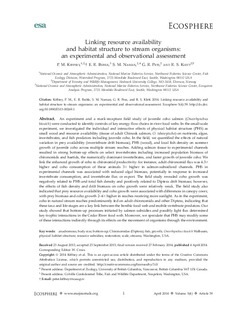Linking resource availability and habitat structure to stream organisms: an experimental and observational assessment
Abstract
An experiment and a mark-recapture field study of juvenile coho salmon (Oncorhynchus
kisutch) were conducted to identify controls of key energy flow chains in river food webs. In the small-scale
experiment, we investigated the individual and interactive effects of physical habitat structure (PHS) as
small wood and resource availability (tissue of adult Chinook salmon, O. tshawytscha) on nutrients, algae,
invertebrates, and fish predators including juvenile coho. In the field, we quantified the effects of natural
variation in prey availability (invertebrate drift biomass), PHS (wood), and local fish density on summer
growth of juvenile coho across multiple stream reaches. Adding salmon tissue to experimental channels
resulted in strong bottom-up effects on select invertebrates including increased population biomass of
chironomids and baetids, the numerically dominant invertebrates, and faster growth of juvenile coho. We
link the enhanced growth of coho to chironomid productivity: for instance, adult chironomid flux was 4.33
higher and coho consumption of these animals 33 higher in salmon-subsidized channels. PHS in
experimental channels was associated with reduced algal biomass, potentially in response to increased
invertebrate consumption, and invertebrate flux or export. The field study revealed coho growth was
negatively related to PHS and total fish density and positively related to Diptera drift biomass; however,
the effects of fish density and drift biomass on coho growth were relatively weak. The field study also
indicated that prey resource availability and coho growth were associated with differences in canopy cover,
with prey biomass and coho growth 2–43higher in reaches receiving more sunlight. As in the experiment,
coho in natural stream reaches predominantly fed on adult chironomids and other Diptera, indicating that
these taxa and life-stages are a key link between the benthic food web and mobile vertebrate predators. Our
study showed that bottom-up processes initiated by salmon subsidies and possibly light flux determined
key trophic interactions in the Cedar River food web. Moreover, we speculate that PHS may modify some
of these interactions indirectly through its effects on the movement of organisms through the environment.
Description
This is an open access article. You can find it online by following this link: http://www.esajournals.org/doi/pdf/10.1890/ES13-00269.1
